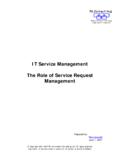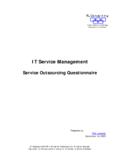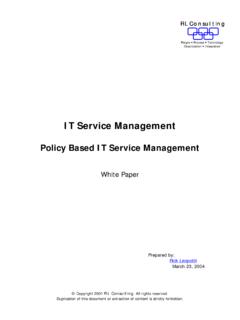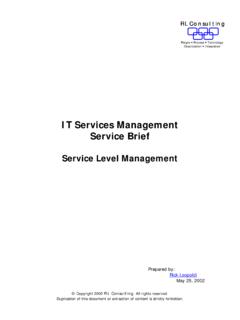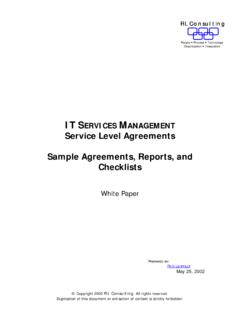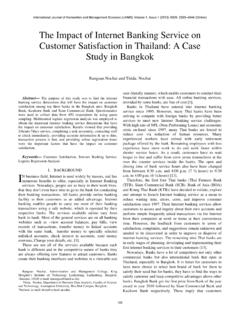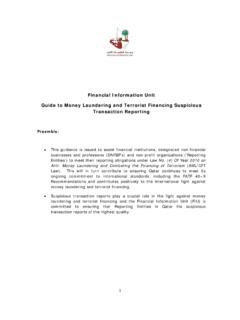Transcription of IT Services Management
1 Copyright 2002 RL Consulting. All rights reserved. Duplication of this document or extraction of content is strictly forbidden. IT Services Management A Description of a Service catalog White Paper Prepared by: Rick Leopoldi June 19, 2002 People Process Technology Organization Integration RL ConsultingRL ConsultingRL ConsultingRL Consulting ITSM - SLA DESCRIPTION RL ConsultingRL ConsultingRL ConsultingRL Consulting Page - 1 People Process Technology Organization Integration This paper discusses the processes and methods to define, characterize, and develop a Service catalog as part of IT Service Management best practices and the relationship between a Service catalog and Service Level Management . Introduction A Service catalog focuses specifically on documenting and articulating the IT Services provided to the organization. Typically it also contains the necessary service level requirements that are usually detailed in a Service Level Agreement (SLA).
2 A Service catalog is part of the Service Level Management area of ITSM. The other co-dependent areas that could described as ITSM linkages with it are service planning, service level objectives and agreements, Availability Management , IT Service Continuity, Capacity Management , and Financial Management . Scope and Description The objectives of Service Level Management Service is to lead IT organizations through the design of a Service catalog , development of detailed service descriptions for their Services , and the development of a Service Level Agreements (SLA) for their major, mission-critical Services that are well-defined, measurable, and in a negotiable state. These Services will then be documented in a Service catalog . From an ITSM maturity perspective, the goals of Service Level Management are: An optimized, service focused organization A well defined and effective set of tailored processes and methods that is supported enterprise-wide and is continuously improved An integrated toolset that is well established and continuously improved as needed One area that denotes Service Level Management maturity within ITSM is the development and maintenance of a Service catalog that includes identifying and qualifying the types of Services being provided and integrating service level objectives and agreements information that employs a business and customer service focus.
3 ITSM - SLA DESCRIPTION RL ConsultingRL ConsultingRL ConsultingRL Consulting Page - 2 People Process Technology Organization Integration Develop a Service catalog within Service Level Management The following are recommended steps for developing a Service catalog : 1) Develop and document a Service catalog that includes identifying and qualifying the types of Services being provided for all major business systems, similar to an inventory of systems that includes a detailed description of each. Over time these Service catalog entries are deepened in breath, scope, and detail dealing with a customer business level focus for transactions and the component areas that comprise it. 2) Develop and document service level objectives. A primary focus should be on internal service such as the technology level for performance and availability. Examples are, network, server response, and up-time . Over time these objectives should be deepened in breath, scope, and detail dealing with a customer business level focus for transactions and the component areas that comprise it.
4 3) Document service level objectives within the Service catalog or develop and document formal service level agreements with customers. (In some IT organizations, individual SLA s are not prepared since they are not charging back for Services . In this case the SLA may be replaced with a Service catalog that defines the same information but without the charges sections. The service catalog then becomes a tool for the IT support organization to establish its own measurable objectives. These objectives identify what the IT staff must do to support the terms of the agreements.) Based on the service level objectives listed above, these agreements will be contracts of guaranteed levels of performance and availability. These agreements need to be reviewed and renegotiated as needed (typically on a cyclic basis, , annually). As the scope, breath, and detailed level of the Service Level Objectives expand so to should the Service Level Agreements.
5 NOTE: It is important that for both the Service Level Objectives and Agreements, they are realistic, can be measured, can be achieved, can be monitored, and are agreed to by both IT and the customers. 4) Put in place the necessary hardware and software technologies to evaluate, monitor, and report on performance and availability. Off-the-shelf software and the associated hardware should be considered initially for practical reasons of maintenance, support, and resources requirements. 5) Put in place the necessary methods and processes for developing, publishing, and maintaining the Service and Operating Level Objectives and Agreements, as well as their evaluation, monitoring, and reporting. ITSM - SLA DESCRIPTION RL ConsultingRL ConsultingRL ConsultingRL Consulting Page - 3 People Process Technology Organization Integration 6) Put in place service managers (and associated resources if necessary) whose primary role and responsibility will be to support Service Level Management enterprise-wide.
6 7) Fully complete the Service catalog , verify it with the user community, and publish it. Assign the responsibility of maintaining and enhancing it. 8) Enhance the Service catalog such that it is integrated with service level objectives and agreements and has a business and customer service focus. 9) Fully develop the other areas of Service Management as defined by ITSM as needed such that an optimized maturity level is attained as uniformly as possible. Relationship to Service Level Management Within the Service Level Management of ITSM there is a focus on translating IT strategy into IT Services , managing the service levels for those Services , and putting in place continuous service improvement processes for these Services . These Services are aligned with business requirements and business strategy. With this focus in mind, service level Management plays a critical role through the development and use of service level agreements that provide the necessary metrics for measuring, assessing, managing, and reporting agreed upon service between IT and its customers.
7 ITSM maturity in the area of Service Level Management is exhibited in several of the following areas: Reactive mode of processes and operation Customer satisfaction (for IT Services ) could be improved Costs are not tracked for the service being provided This includes having defined service level and operating level objectives or agreements, formally defined service manager roles, formal coordinated service reporting to customers, the use of technology being applied to enable service evaluation, monitoring, and reporting. Service Level Management is a process that defines, negotiates, monitors, reports, and controls customer-specific service levels within predefined standard service parameters. It also generates customer-specific Services if the SLA requires it. Where defines means translating customer-specific service delivery requirements into selected values for standard service level parameters and incorporating these into the form of service level agreements (SLA s).
8 This provides for some or all of the following: Increases Customer Satisfaction ITSM - SLA DESCRIPTION RL ConsultingRL ConsultingRL ConsultingRL Consulting Page - 4 People Process Technology Organization Integration Increases Service Quality Decreases Operational Costs Assess customer-specific service requirements Map standard Services to requirements Define customer Services Negotiate and document SLA Establish service performance cycle Design custom Services Analyze customer-specific service level performance Create customer reports Conduct service performance review Propose service improvements (customer-specific) Provides IT Direction and Focus Decreases Time-to-Market Plan for new standard Services Conduct service risk analysis Define functional requirements Analyze capability gaps Make service buy vs. build decision Determine ROI on service development Create internal design specification Develop strategic alliances Evaluate Service catalog impacts Keep Services current Manage Services value Obsolete Services

